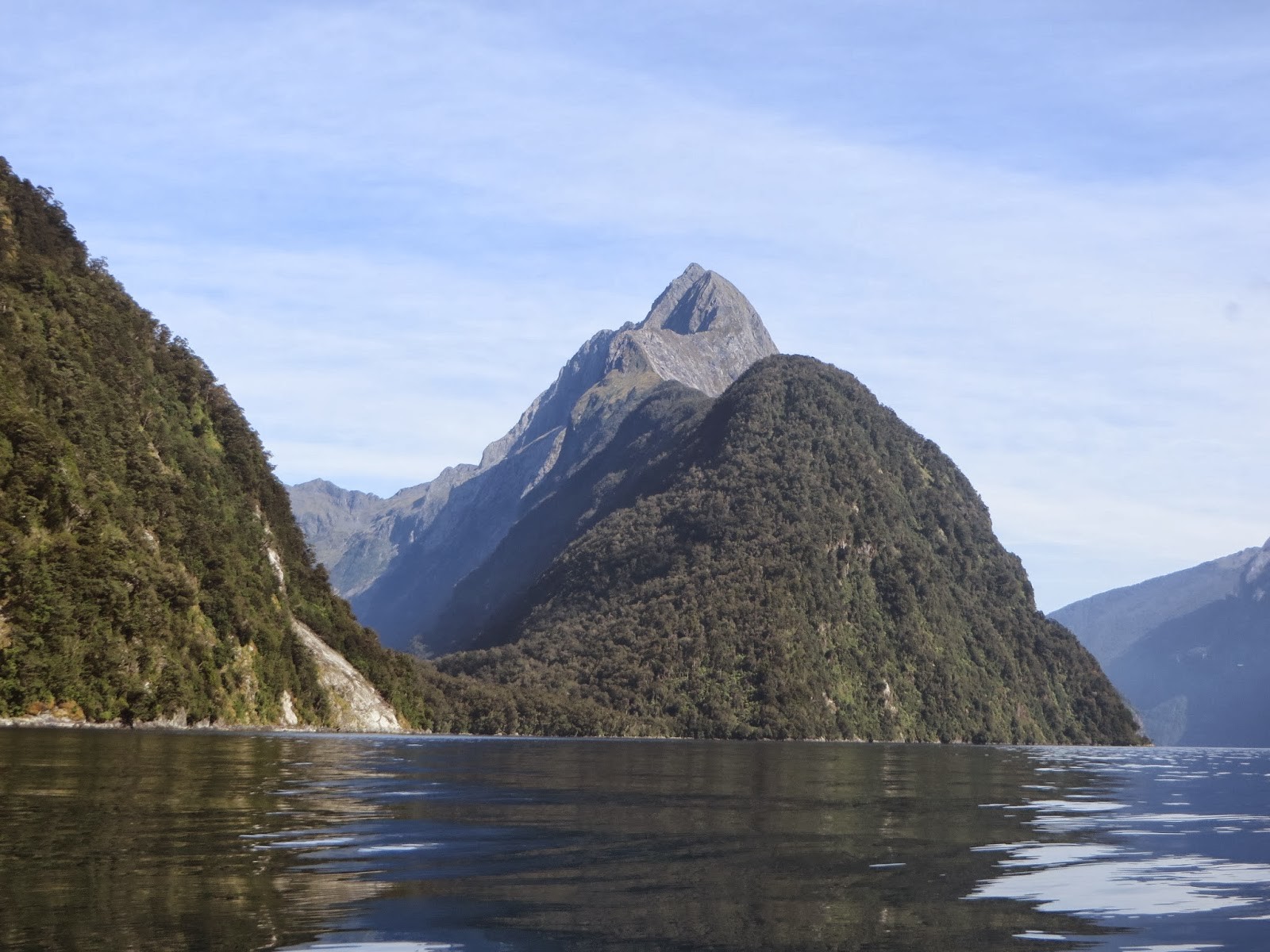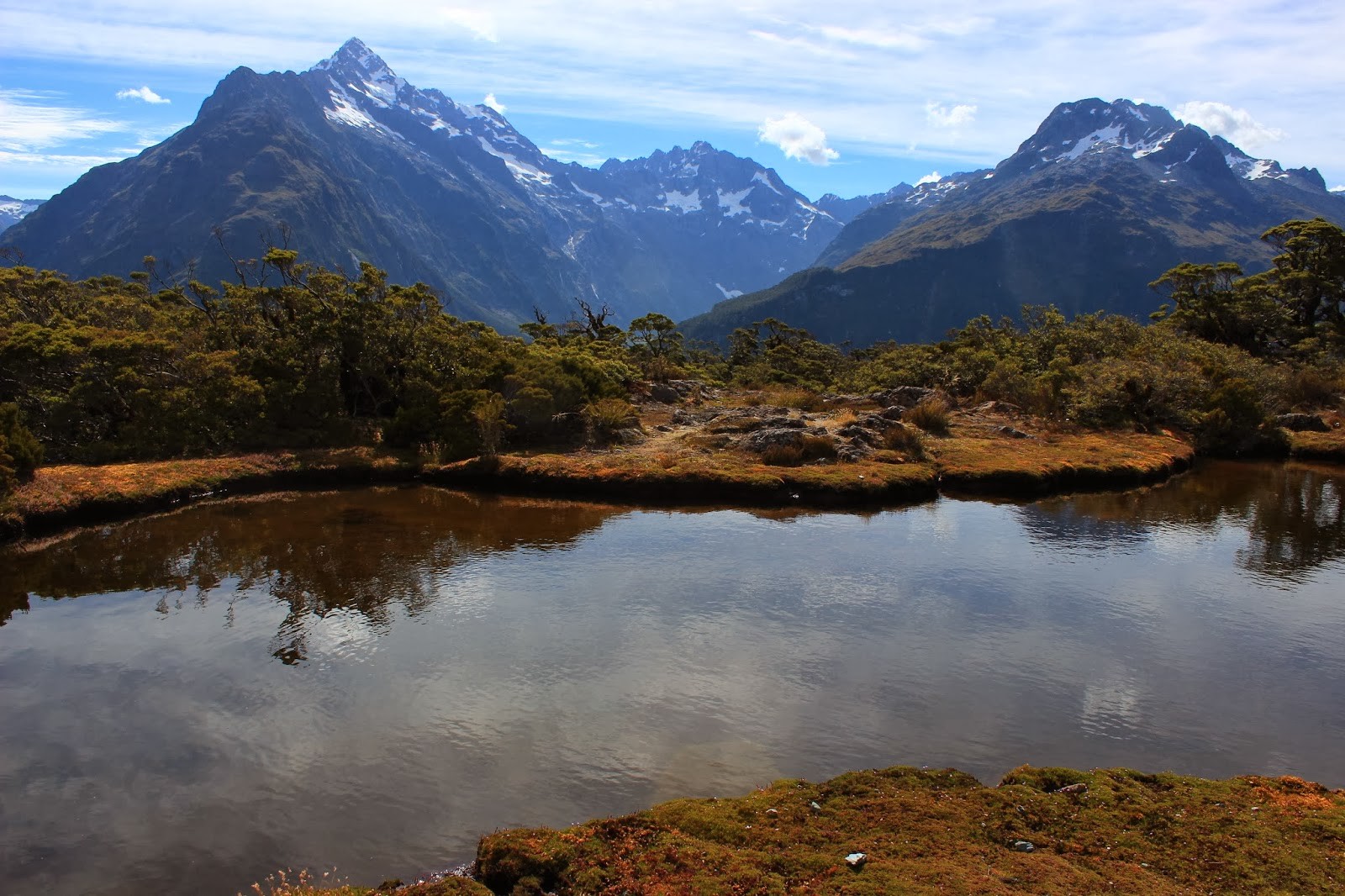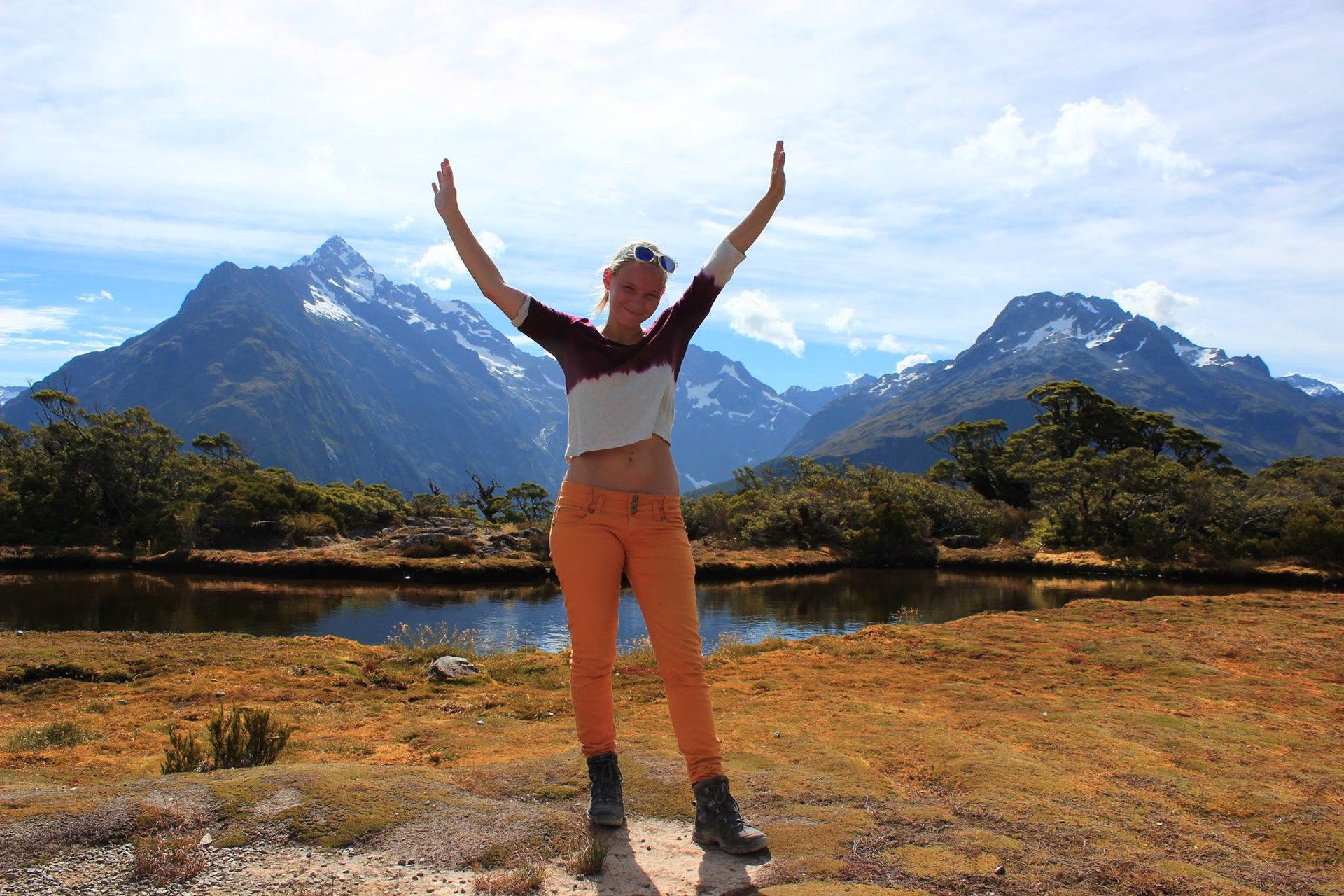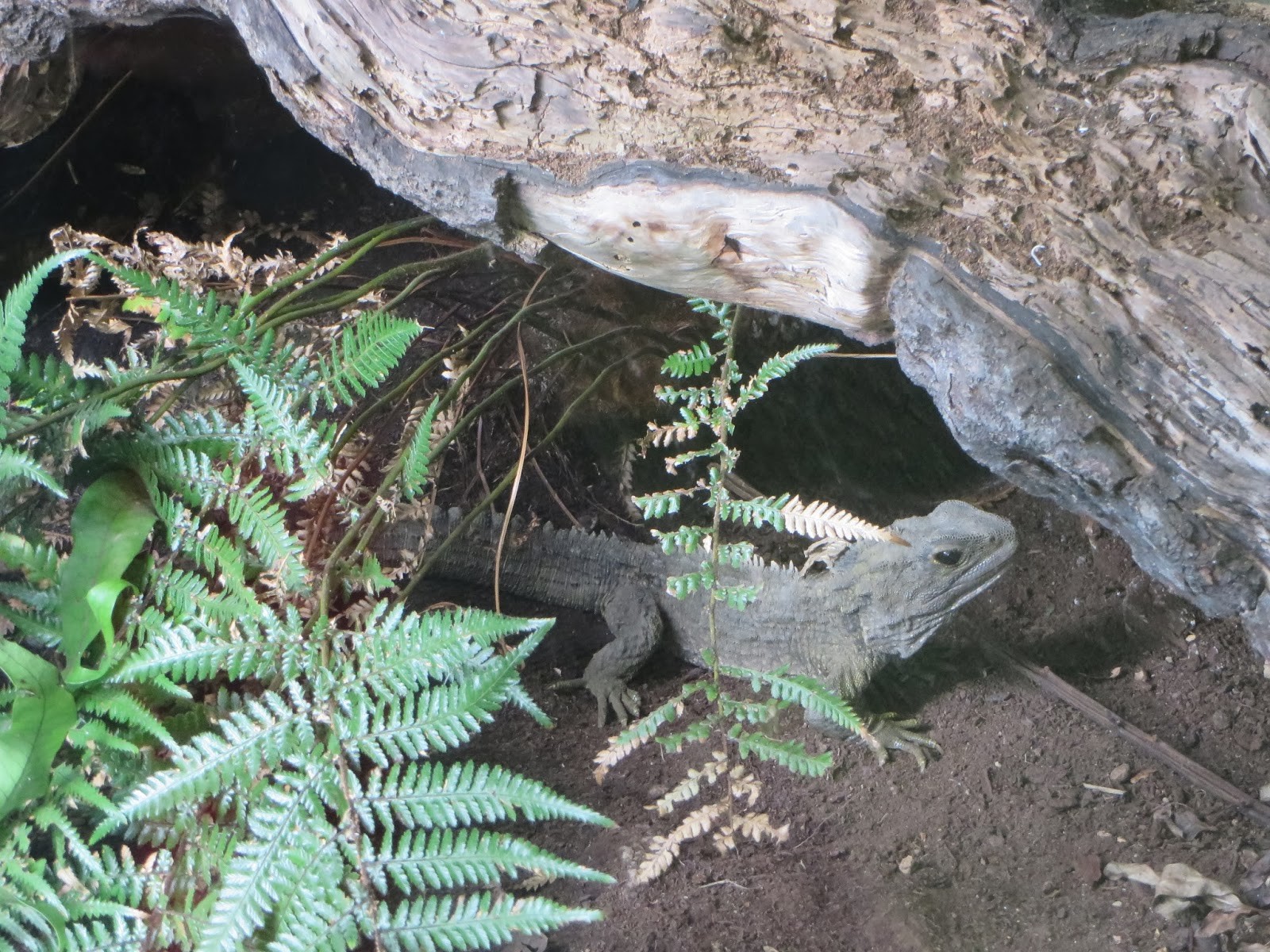Fiordland and Southland
Starting in Te Anau and leading up to the village of Milford, winds the Milford Highway. On this road, you will find many camp site and several small and also longer hiking tracks to special places. As we arrived in the evening, we just stayed at the first camping place at the Lake Te Anau. The next day, we enjoyed the amazing views over the sounds with all the different colours, during the day in all different shades of green, brown, yellow gold and other brighter colours of the flowers, at night turning in thousand shades of grey and blue. We did some small strolls around the lake.
The next day, we continued on the Highway to Milford and stopped at some sights. The most important of them are the Lake Mistletoe, Eglinton Valley – normally, you have fantastic views on the mountains, but that they the clouds were so deep and covered the mountain tops. Luckily on the way back, we had more luck and could enjoy the view-, the Mirror Lakes – where you have to be in the morning as at that time there is no wind and the water crystal clear, so that everything mirrors in the water. There is a sign saying upside down Mirror Lakes and in the morning, you can read it in the lake – and some short hikes. Overnight, we stayed at the last camping place on the road at the Lake Gunn. Once again, truly amazing landscapes!
The next morning, we had to be in Milford at 8:30 o’clock to start our kayaking tour, that meant getting up very early, especially if you are in company of someone who always takes long. Eight people and a guide started their way. We had to change our clothes to bathing suits and some wetsuits of them and then got some instructions about how we are going to behave in the group, in the ocean and in case of emergency. And then, we already started. Always two people got a kayak – apparently, these are more stable than the single ones and better suited for beginners.
We started paddling in good mood and our guide told us many things about the Milford Sound. The Milford Sound is actually not a Sound. A sound is a landscape shaped through rivers and the Milford Sound developed, as all the other sounds here as well, from the movements of the glaciers. These kinds of landscapes are fiords, so actually the Milford Sound should be called Milford Fiord. But as the New Zealand people don’t want to rename all the sounds and Milford Sound is a lot easier to pronounce than Milford Fiord, they just called the whole region Fiordland and left the rest of the names as they were. Our first station were the Bowen Falls, a waterfall of a height of about 162 metres. From here, we could already see the famous Mitre Peak – one of the most seen post card pictures -, the highest mountain in the Milford Sound. Counting also the part under water, he is almost 2 kilometres high!
We wanted to continue to the famous and very high Stirling Falls, but our guide told us it was too far. We said, it doesn’t look so far and he let us estimate the time to get there by kayak. We said about half an hour. Actually, it would be more than two hours and it is because of the immensely high mountains that we underestimate the distances and times to get there. We were a bit disappointed, but finally accepted the fact and enjoyed our tour. We continued in the direction of Mitre Peak and then went on land on the opposite side to get our lunch and warm drinks. We got to know that in the surrounding Fiords lived a great variety of animals that were already extinct in the rest of the island as here the Fiords were so steep that no predator could get there. It is only possible for flying animals and mostly a great variety of colourful birds live there.
Here in the waters, it is also possible to meet seals – we were lucky to see some -, blue penguins and dolphins– with the last two we were not so lucky and at that point, meeting seals was already a routine for us.

After lunch, we crossed the Sound and started our way back. As in the afternoon the wind almost always blows in the direction of the land, the sails get taken out and the kayaks do a raft up, which means all have to gather and hold on to each other. The two persons outside in the front row, hold the lower corners of the sails and the outside people in the back knot the ends of the sail to their paddles and then hold it up. Like that you create a real sail and if there is wind, you can sail back very fast. We weren’t really lucky with the wind and soon gave up and paddled back. Already close to our starting point, we tried another kind of sailing. Everyone holds together and either the whole front or the whole last row stands up and tries to catch the wind with their jackets. As the wind was stronger now, it worked a bit better, but also not ideally. Even though, it had been an amazing experience. In total, we had been five hours kayaking.
Afterwards, we had to change and bring away our kayaks. As it was not too late, my boyfriend and I decided to go hiking for some hours and first went to a gorgeous gorge and then up to the Key Summit. The way up to the Key Summit is actually part of the Kepler Track, also one of the 7 Great Walks in New Zealand, and a post card image that I had seen several times and just loved. So, of course, we went to see how it looks in reality. Stupid how we were, we thought as it is only a few hours – don’t remember quite well, but think about two hours – we left everything behind and didn’t even bring our drinks, because we didn’t want to carry anything. We noticed our mistake, when we reached the tree less part and were exposed to the hot sun and of course, you need something to drink on a two hours’ hike. But, everything went well, we arrived on the top and had a truly fantastic view over the mountains and the Fiord! Also, the way down went well and the first thing arriving at the car, was to drink a whole bottle of water. Never again hiking without!
The next day, we went on to Southland and the Catlins.


Before arriving there, we stopped in Invercargill and went to the Southland Museum. There are many things, but the one thing we wanted to see were the Tuatara lizards. They already live on earth for 35 million years and are threatened by extinction and because of these they try to revive the species by breeding them in the museum. The special thing about them, is that they still have their third eye, but which cannot be seen as scales cover it. But they still use it for noticing light differences.

In the Catlins, we camped in Curio Cay – which looked a bit like I imagine Scotland –, where we saw a herd of dolphins and in the evening, we could see the Yellow-Eyed-Penguins to come at the shore and feed their babies. There are some very good places to observe them with enough distance. They are actually also threatened by extinction, because people always go to close to them and they are afraid to come ashore and leave their babies to die. It is so sad what the stupidity of humans does to nature. The penguins are tall, I would guess about half a metre and have yellow eyes and it looks like they used yellow eyeliner to draw very elegant lines. The babies don’t have them as clear as the parents and are still very fluffy and so clumsy. One of them fell several times from a rock. The region, where we observed them is actually a petrified forest. The trees had fallen, I don’t remember why, and it was because of the sea, that they got petrified. Really interesting structure.
This day and the next one, we still did some hiking tracks to many different waterfalls, lakes and light houses. And we did that and were always happy to see the beauty of nature, even though it heavily rained.
High time to get back to the warm north.



Photo gallery
Content available in other languages
- Español: Fiorland y Southland
Want to have your own Erasmus blog?
If you are experiencing living abroad, you're an avid traveller or want to promote the city where you live... create your own blog and share your adventures!
I want to create my Erasmus blog! →










Comments (0 comments)